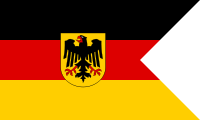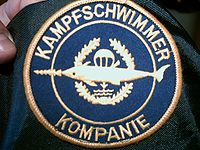- German commando frogmen
-
This article is about Germany's commando frogmen. See also Minentaucher.
For other nations' commando frogmen, and information about frogmen in general, see Frogman.Kampfschwimmer
Current Unit PatchActive 1958 - Present Country  Germany (Deutsche Marine)
Germany (Deutsche Marine)Branch German Navy Type Special Operations Role Naval Special Forces Size 250 men Garrison/HQ Eckernförde Motto Lerne leiden, ohne zu klagen! (Learn to suffer without complaint!) Engagements Gulf War, Adria, FR Yugoslavia, Operation Enduring Freedom, Afghanistan
German Navy
Deutsche Marine
Components Organization Ships Naval Air Arm Kampfschwimmer Command Fleet Command Marineamt Equipment Ship Classes History and Traditions Prussian Navy Norddeutsche Bundesmarine Kaiserliche Marine Reichsmarine Kriegsmarine Volksmarine Awards, Decorations and Badges Badge of Honour of the Bundeswehr
Military Proficiency Badge
Badge of Marksmanship
Service Medal
Flood Service MedalGermany's postwar commando frogman force are called the Kampfschwimmer ("Combat Swimmers") or Verwendungsgruppe 3402 (Usage Group 3402). They are the only special-purpose force of the German Navy. The Kampfschwimmer were set up when Germany joined NATO in 1958.
During the GDR (East Germany), the People's Navy of the GDR also had a commando frogman force, which was stationed in Kühlungsborn. They trained at Prora on Rügen.[citation needed]
Contents
History
World War II timeline
History of operations
1942 - 1943
- 1942 onwards: The amateur diver Alfred von Wurzian tested breathing apparatuses for the German army.
- 1943: Admiral Karl Dönitz orders vice-admiral Hellmuth Heye to create a special unit. One gives him the name of Kleinkampfmittelverband (= Small ordnance association) but it is better known under the name of K-Verband. Its first men, including von Wurzian, were trained by Italian Decima Flottiglia MAS men, who already had much experience. (The German SS also had a frogman section.)
1944
- 1944 June: Three German frogman units called MEK = Marine Einsatzkommando become active. Each unit had one officer and 22 men. But they were not ready for D-Day.
- 1944 June 23: German naval frogmen blow up two bridges on the Orne river, using two torpedoes of 800 kg.
- 1944 July: There were several attacks by German Neger craft in the English Channel, setting off from Villers sur Mer. On July 8, these attacks badly damaged the cruiser ORP Dragon (which was scuttled on July 20), and sunk the destroyer HMS Isis. 12 attack boats were used in attacks in the mouth of the Orne river.
- 1944 September 16: By this time the Allies had taken Antwerp. 2 teams of 5 German frogmen left Rotterdam on two attack boats, to attack Antwerp docks. When they were stopped by defence nets, the teams continued by swimming, each towing a torpedo with a ton of explosive. One team placed its torpedo on the main canal lock in Antwerp. The lock was out of use for 3 months.
- 1944, night of September 28–29: By now the Allies had taken intact a road bridge at Nijmegen and a railway bridge at Moerdijk, and had immediately installed a strong anti-aircraft defence there. 3 groups of 4 German frogmen set off from 10 km upstream from the bridges. They were to place explosives under the bridges and then to continue with the river current 24 km further to return to their lines. The railway bridge was blown up. The road bridge was only slightly damaged because the mine had been badly placed. Of the 12 men, 3 were killed, 7 were captured, and 2 returned to their lines.
- 1944 December: German frogman operations in the Vistula river.
- After Italy changed sides, the German frogman unit MEK71 based in Jugoslavia made numerous attacks against liberated Italy, using two-man canoes.
1945
- 1945 February : German frogmen operations in the Oder river.
Craft developed by Germany during World War II
- The "lentil". It is a fast silent boat carrying 300 kg of explosive The pilot directs it and then jumps in the sea and is collected by another boat.
- A "chariot" copied from that of the British who copied it from the Italian maiale. The Italians never transmitted to the Germans the plans of their maiale.
- The "Neger" (German for "negro"), a single-seat torpedo sailing awash at 4 knots. Its pilot leaves it before precipitating it on the objective.
- Creation of pocket submarines (one-seater and two-seater).
Incompletely planned operations
- Plan to attack the underwater oil pipeline PLUTO.
- Plan to block the Suez Canal by sinking boats in it.
Post World War II
- This section was translated from de:Kampfschwimmer (Bundeswehr); refer back there in case of query about the translation.
The Kampfschwimmer were set up particularly because Germany joined NATO and there was felt to be risk of war with the Soviet Union. A unit was needed which could help to secure the Baltic Sea exits through the Danish Straits. On 1 August 1958, Group 3402, as these commando frogmen were called by the navy, was set up. It consisted of men without a Nazi past, who had served in World War II in the small combat forces and the naval employment commands.
The first Kampfschwimmer were trained first with the Nageurs de combat in France. France had developed the role of the commando frogmen further in the Indochina war, to the modern single fighter.
The Kampfschwimmer should carry out their tasks both in the water and ashore, like German commando frogmen did in World War II. But now a new dimension was added: Air. This three-role concept of the French became the basis of the commando frogmen of the German navy.
On 1 April 1964, the Kampfschwimmer appeared for the first time as an independent body. In the following years they extended their tasks, but lacked money. Thus e.g. they had to buy their own drysuit undersuits.
Roles
In the Gulf War in 1991, the whole company was used for security missions on the German ships involved in the Persian Gulf.
As a boarding party they were involved in embargo control against the remainder of FR Yugoslavia in the Adriatic Sea.
According to rumours[who?] they were involved in Operation Enduring Freedom in the horn of Africa as a boarding party, and they are also in Afghanistan (ISAF and Operation enduring freedom) In 2009 German newspaper websites circulated claims that German Kampfscwimmer had seized the cargo vessel Arctic Sea in Swedish territorial waters in July of that year. Allegedly, the vessel was brought through the Kiel canal where illegal weapons were secretly unloaded and seized by German authorities.
Organization
Since 1974 the Kampfschwimmer have been stationed in the naval base at Eckernförde near Kiel. In October 1994 they were subordinate to the Flotilla of Mine Warfare. In Eckernförde a combat frogman group was set up, it consists of a mine clearance diver company and a commando frogmen company. Allegedly the weapon diver group has 250 men. The commando frogmen company had, according to strength and equipment records, 3 groups, each with 16 men. Of it, approximately 40 men are actively operational.
In 2001 the Waffentauchergruppe ("Armed Diver Group") became the Bataillon Spezialisierter Kräfte ("Specialised Forces Battalion").
By a transformation in 2003 the de:Spezialisierte Einsatzkräfte Marine ("Specialised Task Forces of the Navy") was formed. The SEK M was divided further into the Combat Swimmer Company, a mine clearance diver company, and two naval companies for special employments (e.g. to board ships), a training inspection group, and further support elements.
Conditions for entry
These minimum requirements must be fulfilled by all candidates, to become certified for training:
- Applicants must be German citizens in the sense of the article 116 Grundgesetz (constitution).
- They must be at least 17 years old and less than 25 years old.
- They possess a Realschulabschluss school qualification (10 years), or equivalent
- They were successfully educated at a high school or equivalent, with favorable exam passes.
- 1000m swim in less than 23 minutes
- 5000m run in less than 24 minutes
- 30m distance swim underwater without equipment
- Stay underwater without breathing for at least 60 seconds
- Sport test with at least 20 points; at least 3 points for each exercise
- Must be an active duty soldier who has served at least 6 months. After training, one must enlist for 4 years.
- Diving fitness is examined by the Schifffahrtsmedizinisches Institut (naval medical institute) of the navy.
- Parachute jump fitness is examined by the same institute.
Training
During the training, it is less about the physical load than the psychological load, which causes many applicants to give up. The physical achievement can be trained, but overcoming the fear is the most important goal of the training. The training includes but is not limited to swimming, diving, navigation, close combat, weapons handling, and parachuting. In the special conclusion exercise their ability and hardness are equally demanded, before they join the circle of the commando frogmen. In further training sections they are trained as team leaders or specialists.
Introductory training
First there are four weeks of introductory training. In this time the applicants are pushed hard physically and psychologically by fixed exercises. All exercises have the goal to take away the fear of water and to make the applicant feel safe in the water. One of the exercises is called gefesseltes Schwimmen (= the bound swimming). The applicant is placed on the starting block in the full combat suit, with his hands tied behind his back and his feet tied together, and then pushed in the swimming pool. He must stay for 30 seconds alone clearly; afterwards a safety diver pulls him back up.
In the so-called "hate week" the trainees are deprived of sleep. Between the night exercises, there are night runs. Meanwhile the normal routine of the day continues: swimming, diving, and push-ups.
They also have to train to exit a submarine through a torpedo tube and must re-enter it through there. At the final examination they have to swim about 30 KM with full equipment in the baltic sea to reach the beach after being discharged at the sea.
See also
- KSK
- COMSUBIN
- SEAL Team Six
- US Navy SEAL
- Special Boat Service
- GSG 9
- FBI HRT
- Spezialeinsatzkommando
- CIA Special Activities Division
- MARSOC
- Marine Force Recon
- Zentrale Unterstützungsgruppe Zoll
- MARCOS
- Shayetet 13
External links
- http://www.sondereinheiten.de/einheiten/kampfschwimmer/ (in German)
- http://www.marine.de Seiten der Marine (in German).
- Book: Probst, Wilhelm: Kampfschwimmer der Bundesmarine. Innenansichten einer Elitetruppe, October 2001, ISBN 3-613-02148-X
- http://www.minentaucher.net -- the German/English spoken Minentaucher website
- http://www.kampfschwimmer.de -- the German/English spoken Kampfschwimmer website
Categories:- Frogman operations
- Armed forces diving
- Special forces of Germany
- German Navy
Wikimedia Foundation. 2010.


